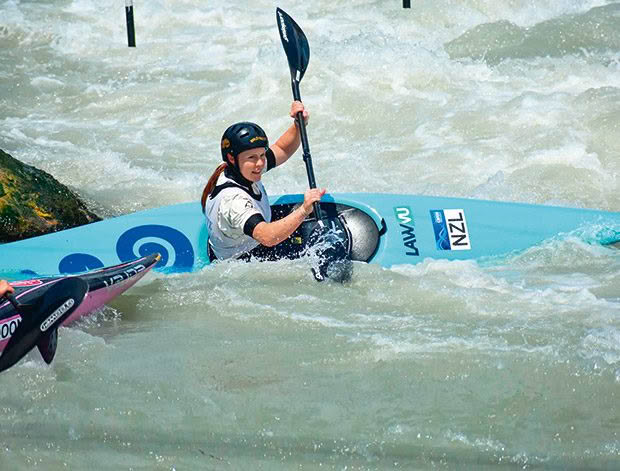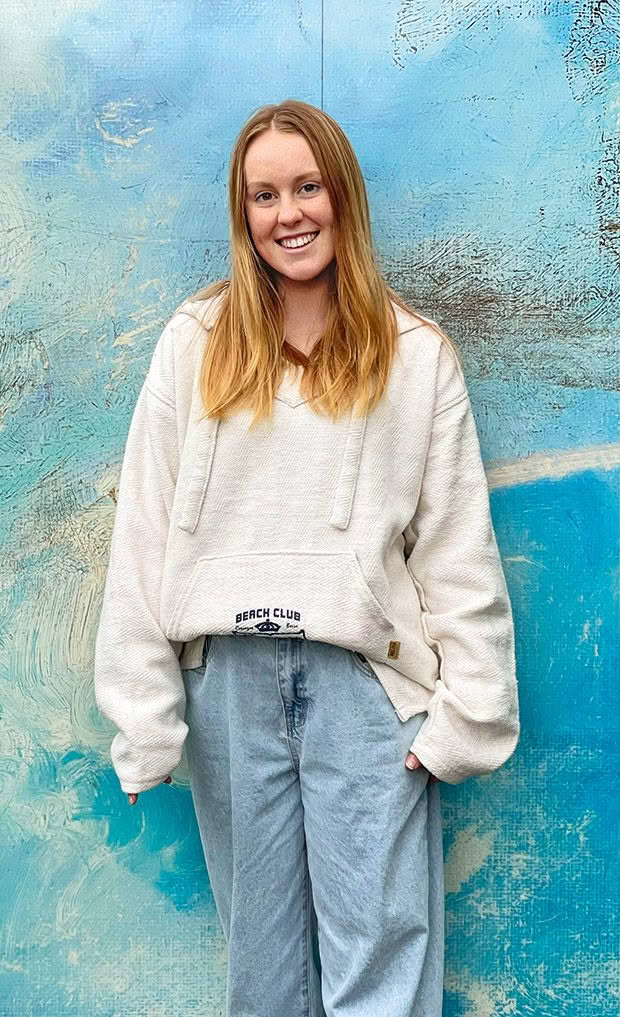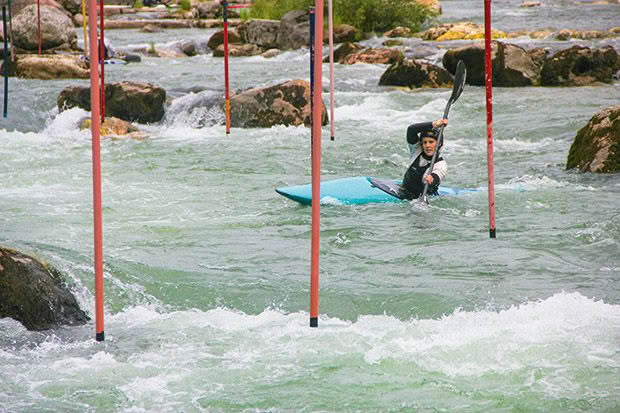What is canoe slalom? It was (once) the scariest thing New Zealand champ Holly Sheaff ever did

Canoe slalom is not a sport for the faint-hearted. Paddlers must beat the clock, their opponents and, most challenging of all, turbulent water. One teenager is up for the run.
Words: Heather Kidd
Canoe slalom is renowned as one of the world’s most breathtaking sports. An athlete must complete a whitewater run in no more than 100 seconds, paddling through a series of downstream and upstream gates, fighting against or working with the current while negotiating hazards such as boulders or rocks, drops, eddies and holes. It’s fast and furious, thrilling yet terrifying, and according to New Zealand’s under-18 No.1-ranked female, Holly Sheaff, enormous fun.
Holly, 18, who recently represented New Zealand at the Canoe Slalom Junior World Championships in Italy, took up the sport six years ago when she was a year-eight student at Mt Maunganui Intermediate. She wanted to participate in the AIMS Games, which have become a highlight on the national sports calendar for intermediate students. The previous year, Holly and her friend Kahlia had participated in aerobics and multi-sport events.
“We intended to sign up for the same events when we noticed a blank sheet of paper on the noticeboard. It was for canoe slalom,” says Holly. “I had no idea what canoe slalom was, but Kahlia thought it had something to do with kayaking. As we’d both kayaked before, we decided to sign up for it. In the games, we did quite well.”

The whim quickly became much more — and not without a few major surprises along the way. “When I started, it was all about paddling on flat water and negotiating around big buoys. Once I joined a club, they talked about getting me to a level where I could paddle on the Kaituna river in Rotorua.”
Holly was taken aback as Kaituna is a serious whitewater course. “Starting out, it was terrifying, the scariest thing I’d ever done. When I flipped for the first time, I genuinely thought I would drown. But over time, you learn how to get back up, and as you get better and become more comfortable on the water, it gets easier. You forget it’s scary and focus on your technique.”
Canoe slalom is a technical sport and difficult for novice paddlers. Patience and practice are essential if basic skills are to be mastered and Holly says once those are ingrained, taking on courses quickly becomes easier and less intimidating.
There’s no substitute for experience, she says. “It helps a lot because you can see how the water moves. You start to get an idea of how the river’s working, and at that point, you can paddle anywhere and be comfortable knowing where to go and what to do. Obviously, mistakes are still possible, and a lot of rolling happens. But it’s all part of the fun.”
As much as canoe slalom appeals to Holly the adrenaline junkie, she has a seriously studious side. She has just completed her first year at university in Auckland, studying for a BSc majoring in chemistry. Anything less than an A average is unacceptable to her, so while overseas for the build-up to and competing in the Junior Worlds, she juggled practice and racing with her studies. She also sat three exams online.
“I’m always trying to do the best I can. While sometimes it can be tough, I like to think I keep things balanced. The combination of sport and study keeps me on my toes.”
If the unpredictability of her sport seems at odds with her laser-focus attitude to life and academia, there’s something refreshing about her acceptance of its vagaries. “No matter how hard you train or plan for a course and prepare, it’s near-impossible ever to have a perfect run. Because the water is so unpredictable, it’s almost certain the run will not go as planned. Having to think quickly, to make a split-second decision to change course slightly, is the hardest part. That, and accepting you’ll never have a perfect run, to be happy with near-perfect.”

Holly can recall a moment during her second run at the Junior Worlds, held in Ivrea in northwest Italy, which was close to perfect. The timing couldn’t have been better, as a nervous first run had resulted in a roll and numerous touches. Before her second run, she gave herself a talking to. If she could not pull herself together, her championships would be over.
What happened next was a surreal experience. “I would describe it as almost being out of my head. I remember letting my body do its thing, and with only a few
gates to go, thinking this has gone all right, keep concentrating.
“At the bottom of the course is a screen that shows your time and ranking. I was sixth. To make the semi-finals I had to finish in the top 10. There were only two paddlers after me, so I knew I’d made it through.”
While Holly could not replicate that form in the semi-finals, she was pleased with how she went in her first major international outing, which saw her placed in the top 30 in her category worldwide.
“Before competing, I wasn’t sure how I would stack up against my competition, and I wondered about my future in the sport. Now, there’s no way I’m giving up. I have
a renewed drive to get into the water and train and improve. Next year will be harder because seven or eight of us in the under-23 category will be vying for three world championship spots.”
As well as honing her skills in the K1 (kayak, one person) category, Holly is keen to get into extreme slalom. Her description of this version of canoe slalom makes it sound like dodgems on water, four paddlers in plastic creek boats racing each other. “It’s absolute chaos,” she says. But, then, that’s part of the attraction for this competitive adrenaline junkie.
ABOUT CANOE SLALOM
Although the sport is called “canoe slalom”, paddlers race in either canoes or kayaks. Canoe racers kneel and use a single-blade paddle while kayakers are seated and have a double-blade paddle. Whitewater courses are a maximum of 300 metres in length and can contain up to 25 gates; a minimum of six must be upstream. Downstream gates are green, upstream gates red. Paddlers incur time penalties if they touch or miss gates. A touch will cost them two seconds, a missed gate 50 seconds.
Canoe slalom first appeared at the Olympics in 1972. After a 20-year hiatus, it was reintroduced in 1992 at Barcelona. The sport is especially popular in Europe. New Zealand’s best-known female paddler is Luuka Jones who has competed in four Olympics. She finished second in the K1 event in Rio in 2016 to win New Zealand’s first Olympic medal in canoe slalom.
RACE TIME
In the lead-up to the Junior World Championships, Holly competed in three European Canoe Association (ECA) Junior Cup events. In the first of the race series, held in Valstagna in Italy, she finished second overall to win the silver medal in the under-18 K1W class. In Solkan in Slovenia, she again made the podium, her fifth place in the final on day one and third on day two, giving her an overall third placing.
Her final outing before the Junior Worlds took place on the Ivrea championship course. Despite suffering from water poisoning (taking in too much water), caught during practice sessions, she made the semi-finals and finished a credible eighth.
The fanfare in the lead-up to the Junior Worlds is a treasured memory. “Walking down the streets of Ivrea holding the New Zealand flag aloft was special. Representing my country in a sport that I love, which has been a large part of my life for the past five years, felt amazing.”
Love this story? Subscribe now!
 This article first appeared in NZ Life & Leisure Magazine.
This article first appeared in NZ Life & Leisure Magazine.
